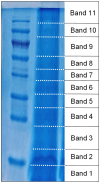Proteomic Analysis and Biochemical Characterization of the Nematocyst Extract of the Hydrozoan Velella velella
- PMID: 39452876
- PMCID: PMC11509761
- DOI: 10.3390/md22100468
Proteomic Analysis and Biochemical Characterization of the Nematocyst Extract of the Hydrozoan Velella velella
Abstract
The venom contained within cnidarian nematocysts has a complex composition and holds significant potential for biotechnological applications. In this context, one of the most effective methods for studying nematocyst contents is the proteomic approach, which can detect even trace amounts of compounds while minimizing the need for large-scale animal collection, thus helping to preserve ecosystem integrity. This study aimed to provide a comprehensive proteomic and biochemical characterization of the crude nematocyst extract from the common hydrozoan Velella velella. Despite not being harmful to humans, the analysis of the crude venom extract from V. velella brought to the identification of 783 different proteins, categorized into structural components, enzymes, and potential toxins, revealing a qualitative composition of the venom similar to that of other more toxic cnidarians. Biochemical assays confirmed the presence of various active hydrolytic enzymes within the extract, including proteases, phospholipases, hyaluronidases, DNases, and chitinases. These findings pave the road for future studies involving the pharmacological applications of Velella velella venom components through recombinant production and functional testing.
Keywords: hydrozoan; proteome; toxins; venom.
Conflict of interest statement
The authors declare no conflicts of interest.
Figures




References
-
- Slobodkin L.B., Bossert P.E. Chapter 5—Cnidaria. In: Thorp J.H., Covich A.P., editors. Ecology and Classification of North American Freshwater Invertebrates. 3rd ed. Academic Press; San Diego, CA, USA: 2010. pp. 125–142.
-
- Technau U., Genikhovich G., Kraus J.E.M. Cnidaria. In: Wanninger A., editor. Evolutionary Developmental Biology of Invertebrates 1: Introduction, Non-Bilateria, Acoelomorpha, Xenoturbellida, Chaetognatha. Springer; Vienna, Austria: 2015. pp. 115–163.
-
- Berzins I.K., Yanong R.P.E., LaDouceur E.E.B., Peters E.C. Cnidaria. In: LaDouceur E.E.B., editor. Invertebrate Histology. Wiley; Hoboken, NJ, USA: 2021. pp. 55–86.
MeSH terms
Substances
LinkOut - more resources
Full Text Sources

